Abstract
1. Using grease-gap recordings from the isolated superior cervical ganglion of mouse, rat and guinea-pig, we have compared the depolarization evoked by 5-hydroxytryptamine (5-HT) with that evoked by the selective 5-HT3 receptor agonist 2-methyl-5-HT (2-Me-5-HT). 2. The maximum depolarization induced by 2-Me-5-HT was smaller than that induced by 5-HT in all three species, and particularly in the guinea-pig. 3. The 5-HT2 receptor antagonist ketanserin (1 microM) caused a clear rightward shift of the dose-response curve to 5-HT on the guinea-pig ganglion, but not on the mouse or rat ganglion. Spiperone (0.03 microM) had a quantitatively similar action to ketanserin (0.1 microM) on the 5-HT dose-response curve of the guinea-pig ganglion. Ketanserin had no significant effect on the dose-response curve to 2-Me-5-HT on any of these ganglia. 4. Using 2-Me-5-HT as the agonist, we determined the pA2 values for two 5-HT3 receptor antagonists. The potency of ICS 205-930 varied by approximately 100 fold between the species and that of (+)-tubocurarine varied by over 1000 fold. The differences in the pA2 values of these compounds varied independently among the species. 5. We conclude that 5-HT3 receptors are present on the superior cervical ganglion from the rat, mouse and guinea-pig, but these receptors may be pharmacologically distinct from each other. In addition, the depolarization of the guinea-pig superior cervical ganglion by low concentrations of 5-HT is largely mediated by ketanserin-sensitive receptors.
Full text
PDF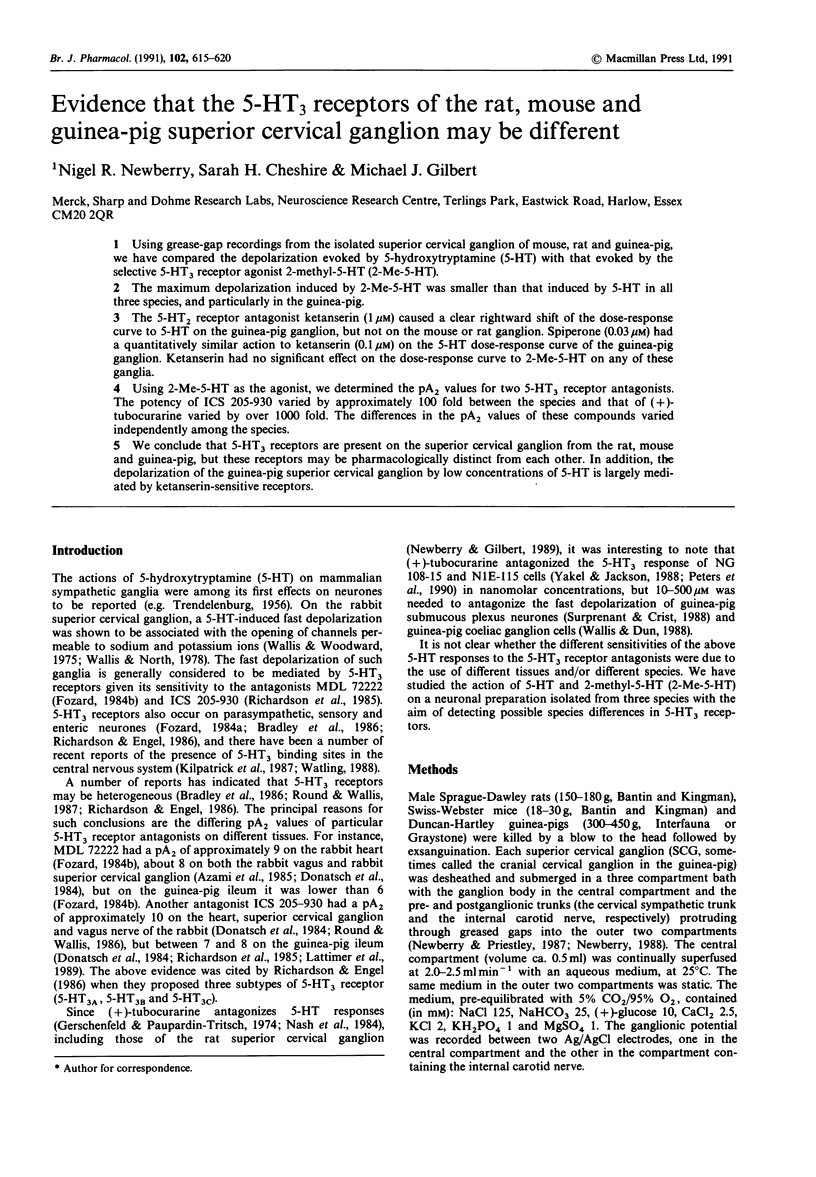
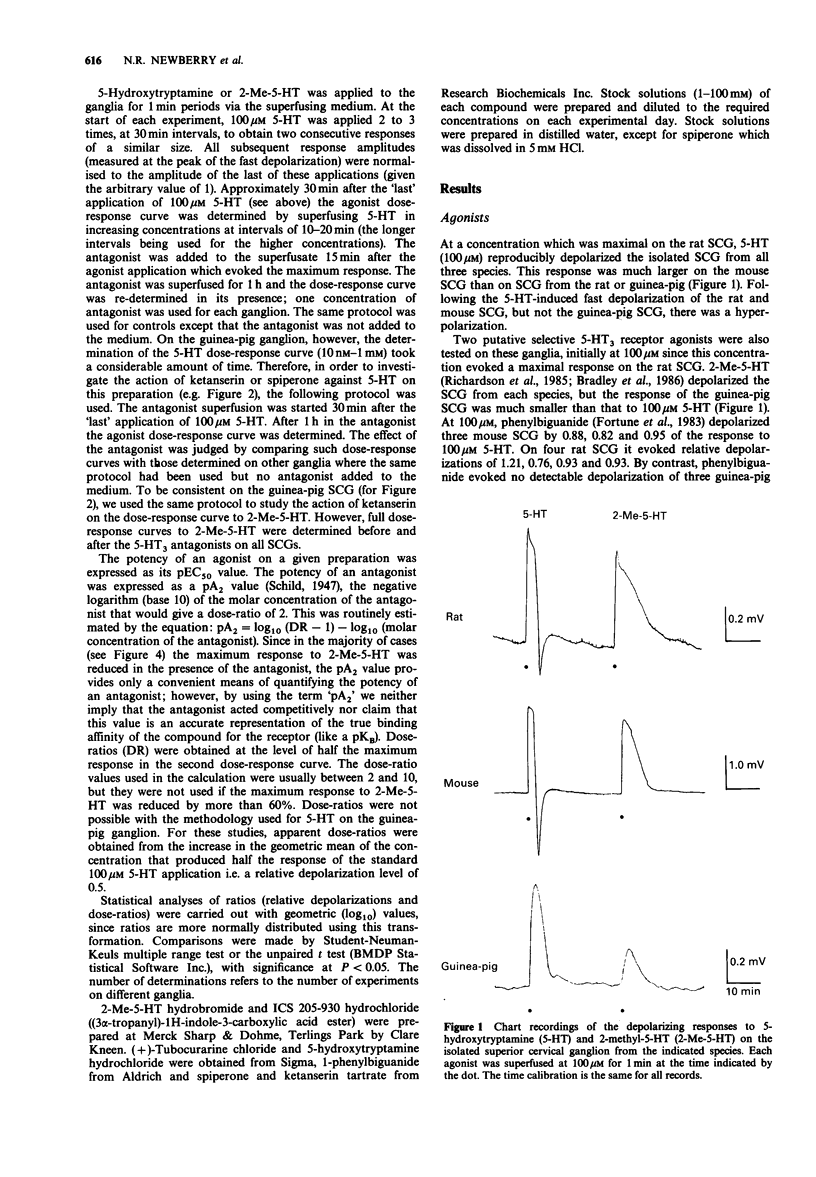

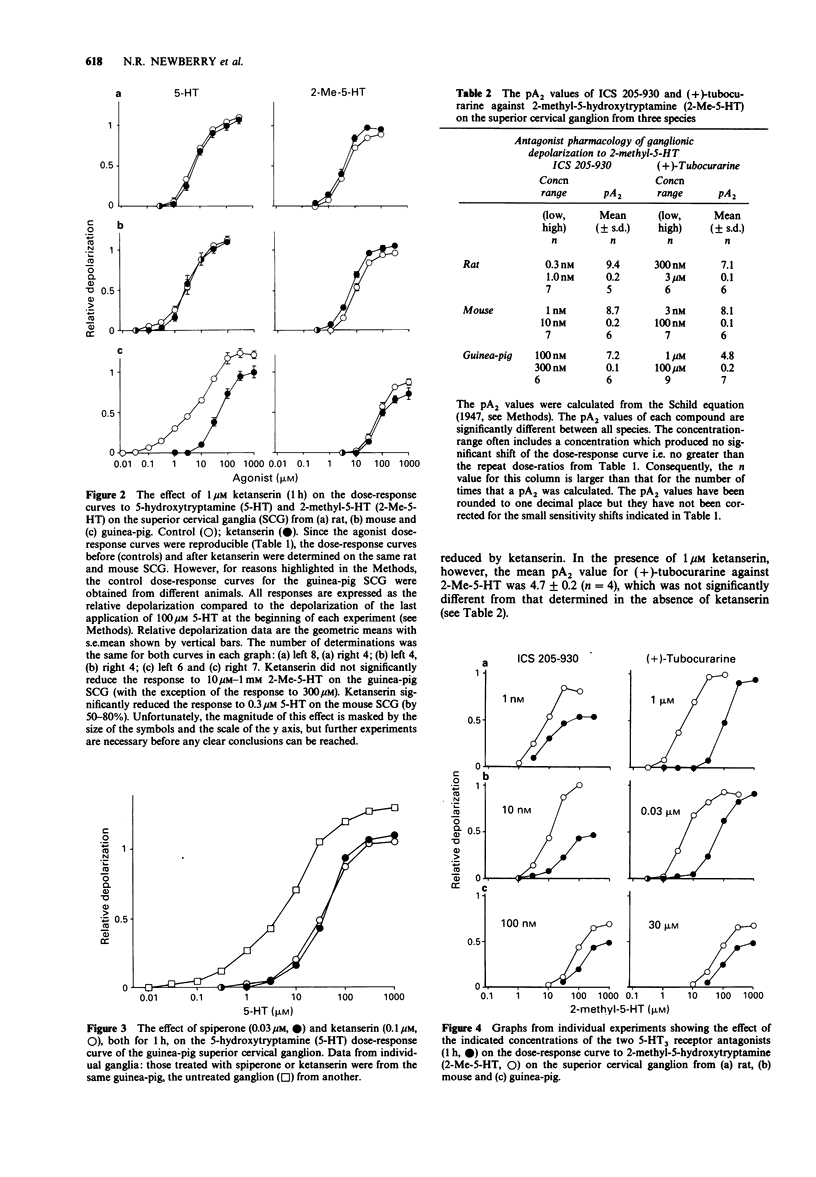
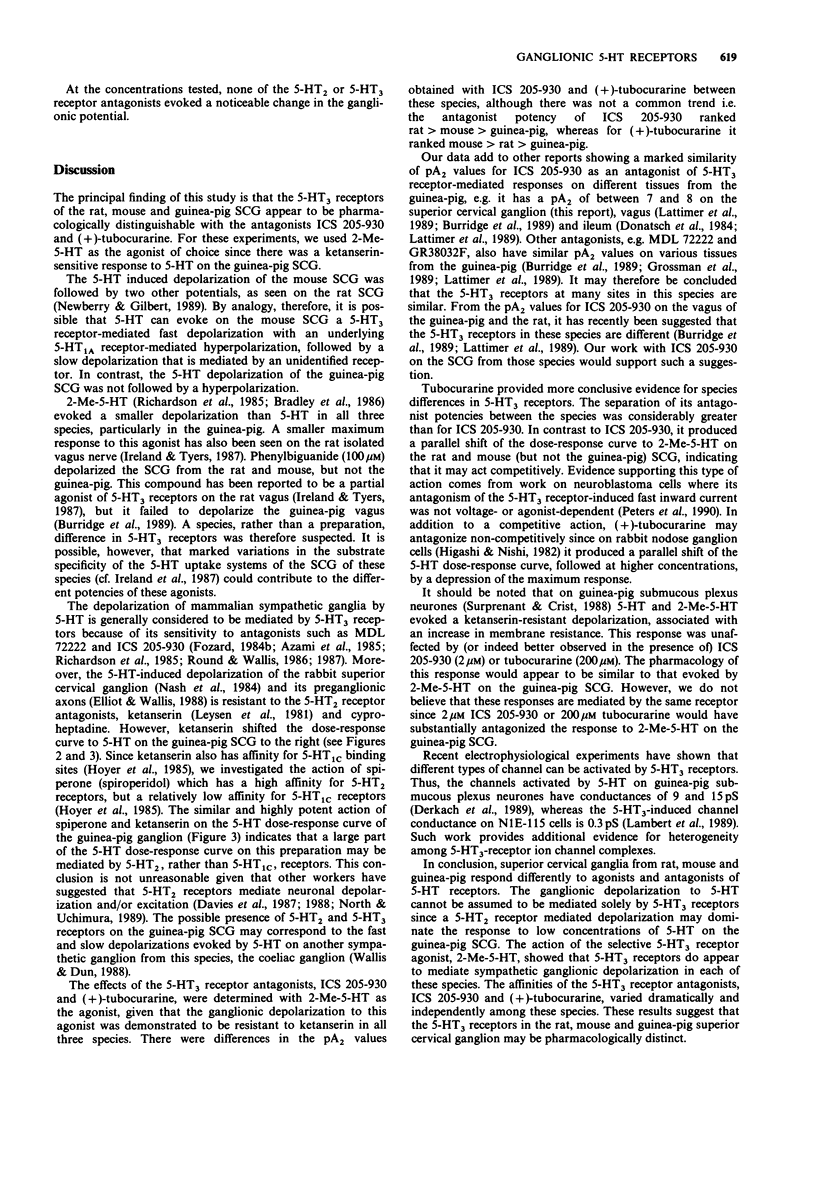
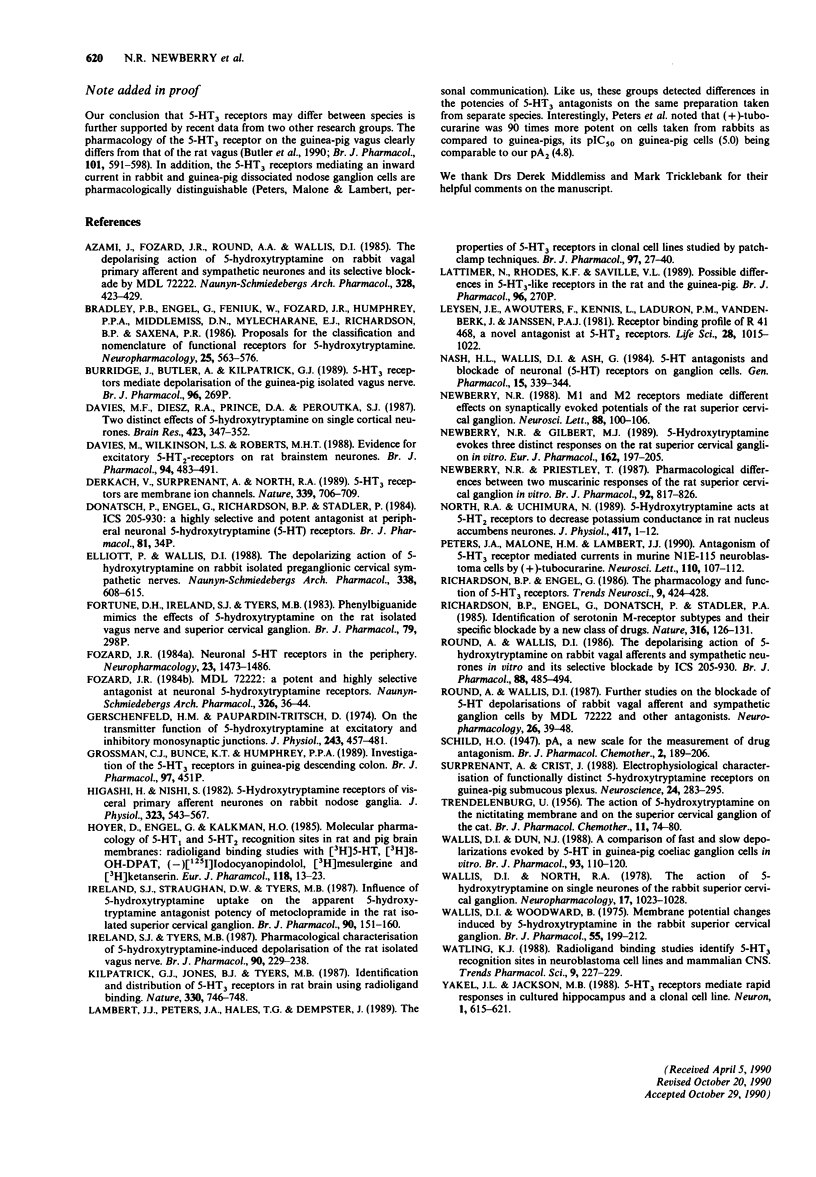
Selected References
These references are in PubMed. This may not be the complete list of references from this article.
- Azami J., Fozard J. R., Round A. A., Wallis D. I. The depolarizing action of 5-hydroxytryptamine on rabbit vagal primary afferent and sympathetic neurones and its selective blockade by MDL 72222. Naunyn Schmiedebergs Arch Pharmacol. 1985 Feb;328(4):423–429. doi: 10.1007/BF00692911. [DOI] [PubMed] [Google Scholar]
- Bradley P. B., Engel G., Feniuk W., Fozard J. R., Humphrey P. P., Middlemiss D. N., Mylecharane E. J., Richardson B. P., Saxena P. R. Proposals for the classification and nomenclature of functional receptors for 5-hydroxytryptamine. Neuropharmacology. 1986 Jun;25(6):563–576. doi: 10.1016/0028-3908(86)90207-8. [DOI] [PubMed] [Google Scholar]
- Butler A., Elswood C. J., Burridge J., Ireland S. J., Bunce K. T., Kilpatrick G. J., Tyers M. B. The pharmacological characterization of 5-HT3 receptors in three isolated preparations derived from guinea-pig tissues. Br J Pharmacol. 1990 Nov;101(3):591–598. doi: 10.1111/j.1476-5381.1990.tb14126.x. [DOI] [PMC free article] [PubMed] [Google Scholar]
- Davie M., Wilkinson L. S., Roberts M. H. Evidence for excitatory 5-HT2-receptors on rat brainstem neurones. Br J Pharmacol. 1988 Jun;94(2):483–491. doi: 10.1111/j.1476-5381.1988.tb11551.x. [DOI] [PMC free article] [PubMed] [Google Scholar]
- Davies M. F., Deisz R. A., Prince D. A., Peroutka S. J. Two distinct effects of 5-hydroxytryptamine on single cortical neurons. Brain Res. 1987 Oct 13;423(1-2):347–352. doi: 10.1016/0006-8993(87)90861-4. [DOI] [PubMed] [Google Scholar]
- Derkach V., Surprenant A., North R. A. 5-HT3 receptors are membrane ion channels. Nature. 1989 Jun 29;339(6227):706–709. doi: 10.1038/339706a0. [DOI] [PubMed] [Google Scholar]
- Elliott P., Wallis D. I. The depolarizing action of 5-hydroxytryptamine on rabbit isolated preganglionic cervical sympathetic nerves. Naunyn Schmiedebergs Arch Pharmacol. 1988 Dec;338(6):608–615. doi: 10.1007/BF00165624. [DOI] [PubMed] [Google Scholar]
- Fozard J. R. Neuronal 5-HT receptors in the periphery. Neuropharmacology. 1984 Dec;23(12B):1473–1486. doi: 10.1016/0028-3908(84)90091-1. [DOI] [PubMed] [Google Scholar]
- Gerschenfeld H. M., Paupardin-Tritsch D. On the transmitter function of 5-hydroxytryptamine at excitatory and inhibitory monosynaptic junctions. J Physiol. 1974 Dec;243(2):457–481. doi: 10.1113/jphysiol.1974.sp010762. [DOI] [PMC free article] [PubMed] [Google Scholar]
- Higashi H., Nishi S. 5-Hydroxytryptamine receptors of visceral primary afferent neurones on rabbit nodose ganglia. J Physiol. 1982 Feb;323:543–567. doi: 10.1113/jphysiol.1982.sp014091. [DOI] [PMC free article] [PubMed] [Google Scholar]
- Hoyer D., Engel G., Kalkman H. O. Molecular pharmacology of 5-HT1 and 5-HT2 recognition sites in rat and pig brain membranes: radioligand binding studies with [3H]5-HT, [3H]8-OH-DPAT, (-)[125I]iodocyanopindolol, [3H]mesulergine and [3H]ketanserin. Eur J Pharmacol. 1985 Nov 26;118(1-2):13–23. doi: 10.1016/0014-2999(85)90658-2. [DOI] [PubMed] [Google Scholar]
- Ireland S. J., Straughan D. W., Tyers M. B. Influence of 5-hydroxytryptamine uptake on the apparent 5-hydroxytryptamine antagonist potency of metoclopramide in the rat isolated superior cervical ganglion. Br J Pharmacol. 1987 Jan;90(1):151–160. doi: 10.1111/j.1476-5381.1987.tb16835.x. [DOI] [PMC free article] [PubMed] [Google Scholar]
- Ireland S. J., Tyers M. B. Pharmacological characterization of 5-hydroxytryptamine-induced depolarization of the rat isolated vagus nerve. Br J Pharmacol. 1987 Jan;90(1):229–238. doi: 10.1111/j.1476-5381.1987.tb16844.x. [DOI] [PMC free article] [PubMed] [Google Scholar]
- Kilpatrick G. J., Jones B. J., Tyers M. B. Identification and distribution of 5-HT3 receptors in rat brain using radioligand binding. Nature. 1987 Dec 24;330(6150):746–748. doi: 10.1038/330746a0. [DOI] [PubMed] [Google Scholar]
- Lambert J. J., Peters J. A., Hales T. G., Dempster J. The properties of 5-HT3 receptors in clonal cell lines studied by patch-clamp techniques. Br J Pharmacol. 1989 May;97(1):27–40. doi: 10.1111/j.1476-5381.1989.tb11920.x. [DOI] [PMC free article] [PubMed] [Google Scholar]
- Leysen J. E., Awouters F., Kennis L., Laduron P. M., Vandenberk J., Janssen P. A. Receptor binding profile of R 41 468, a novel antagonist at 5-HT2 receptors. Life Sci. 1981 Mar 2;28(9):1015–1022. doi: 10.1016/0024-3205(81)90747-5. [DOI] [PubMed] [Google Scholar]
- Nash H. L., Wallis D. I., Ash G. 5-HT antagonists and blockade of neuronal (5-HT) receptors on ganglion cells. Gen Pharmacol. 1984;15(4):339–344. doi: 10.1016/0306-3623(84)90011-9. [DOI] [PubMed] [Google Scholar]
- Newberry N. R., Gilbert M. J. 5-Hydroxytryptamine evokes three distinct responses on the rat superior cervical ganglion in vitro. Eur J Pharmacol. 1989 Mar 21;162(2):197–205. doi: 10.1016/0014-2999(89)90282-3. [DOI] [PubMed] [Google Scholar]
- Newberry N. R. M1 and M2 receptors mediate different effects on synaptically evoked potentials of the rat superior cervical ganglion. Neurosci Lett. 1988 May 16;88(1):100–106. doi: 10.1016/0304-3940(88)90322-9. [DOI] [PubMed] [Google Scholar]
- Newberry N. R., Priestley T. Pharmacological differences between two muscarinic responses of the rat superior cervical ganglion in vitro. Br J Pharmacol. 1987 Dec;92(4):817–826. doi: 10.1111/j.1476-5381.1987.tb11386.x. [DOI] [PMC free article] [PubMed] [Google Scholar]
- North R. A., Uchimura N. 5-Hydroxytryptamine acts at 5-HT2 receptors to decrease potassium conductance in rat nucleus accumbens neurones. J Physiol. 1989 Oct;417:1–12. doi: 10.1113/jphysiol.1989.sp017786. [DOI] [PMC free article] [PubMed] [Google Scholar]
- Patterson T. A., Terry A. V., Jr, Kosh J. W. Prevention of physostigmine-, DFP-, and diazinon-induced acute toxicity by monoethylcholine and N-aminodeanol. Br J Pharmacol. 1989 Jun;97(2):451–460. doi: 10.1111/j.1476-5381.1989.tb11972.x. [DOI] [PMC free article] [PubMed] [Google Scholar]
- Peters J. A., Malone H. M., Lambert J. J. Antagonism of 5-HT3 receptor mediated currents in murine N1E-115 neuroblastoma cells by (+)-tubocurarine. Neurosci Lett. 1990 Mar 2;110(1-2):107–112. doi: 10.1016/0304-3940(90)90796-c. [DOI] [PubMed] [Google Scholar]
- Richardson B. P., Engel G., Donatsch P., Stadler P. A. Identification of serotonin M-receptor subtypes and their specific blockade by a new class of drugs. Nature. 1985 Jul 11;316(6024):126–131. doi: 10.1038/316126a0. [DOI] [PubMed] [Google Scholar]
- Round A., Wallis D. I. Further studies on the blockade of 5-HT depolarizations of rabbit vagal afferent and sympathetic ganglion cells by MDL 72222 and other antagonists. Neuropharmacology. 1987 Jan;26(1):39–48. doi: 10.1016/0028-3908(87)90042-6. [DOI] [PubMed] [Google Scholar]
- Round A., Wallis D. I. The depolarizing action of 5-hydroxytryptamine on rabbit vagal afferent and sympathetic neurones in vitro and its selective blockade by ICS 205-930. Br J Pharmacol. 1986 Jun;88(2):485–494. doi: 10.1111/j.1476-5381.1986.tb10227.x. [DOI] [PMC free article] [PubMed] [Google Scholar]
- Surprenant A., Crist J. Electrophysiological characterization of functionally distinct 5-hydroxytryptamine receptors on guinea-pig submucous plexus. Neuroscience. 1988 Jan;24(1):283–295. doi: 10.1016/0306-4522(88)90331-4. [DOI] [PubMed] [Google Scholar]
- TRENDELENBURG U. The action of 5-hydroxytryptamine on the nictitating membrane and on the superior cervical ganglion of the cat. Br J Pharmacol Chemother. 1956 Mar;11(1):74–80. doi: 10.1111/j.1476-5381.1956.tb01031.x. [DOI] [PMC free article] [PubMed] [Google Scholar]
- Wallis D. I., Dun N. J. A comparison of fast and slow depolarizations evoked by 5-HT in guinea-pig coeliac ganglion cells in vitro. Br J Pharmacol. 1988 Jan;93(1):110–120. doi: 10.1111/j.1476-5381.1988.tb11411.x. [DOI] [PMC free article] [PubMed] [Google Scholar]
- Wallis D. I., North R. A. The action of 5-hydroxytryptamine on single neurones of the rabbit superior cervical ganglion. Neuropharmacology. 1978 Dec;17(12):1023–1028. doi: 10.1016/0028-3908(78)90028-x. [DOI] [PubMed] [Google Scholar]
- Wallis D. I., Woodward B. Membrane potential changes induced by 5-hydroxytryptamine in the rabbit superior cervical ganglion. Br J Pharmacol. 1975 Oct;55(2):199–212. doi: 10.1111/j.1476-5381.1975.tb07629.x. [DOI] [PMC free article] [PubMed] [Google Scholar]
- Watling K. J. Radioligand binding studies identify 5-HT3 recognition sites in neuroblastoma cell lines and mammalian CNS. Trends Pharmacol Sci. 1988 Jul;9(7):227–229. doi: 10.1016/0165-6147(88)90145-9. [DOI] [PubMed] [Google Scholar]
- Yakel J. L., Jackson M. B. 5-HT3 receptors mediate rapid responses in cultured hippocampus and a clonal cell line. Neuron. 1988 Sep;1(7):615–621. doi: 10.1016/0896-6273(88)90111-0. [DOI] [PubMed] [Google Scholar]


